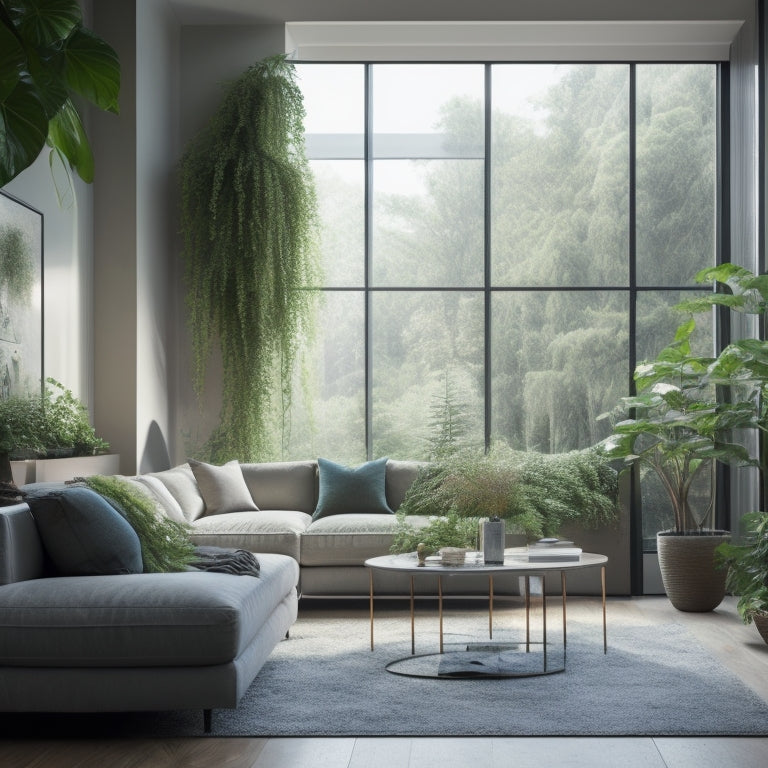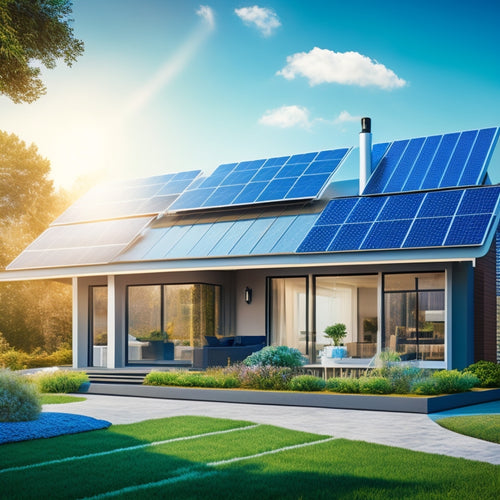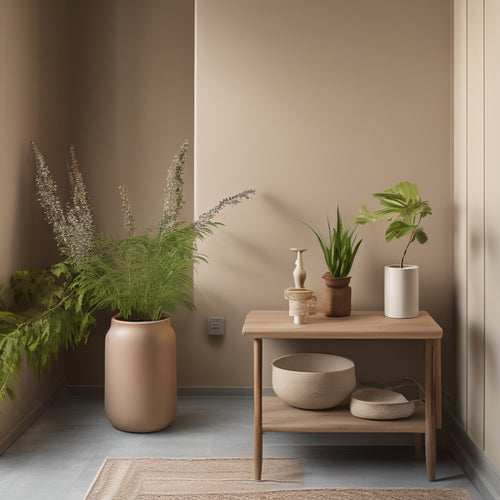
Why Vertical Gardens Reduce Home Energy Consumption
Share
By incorporating a vertical garden into your home design, you'll reduce energy consumption through natural insulation and thermal mass. Plants will regulate your home's temperature, reducing heating and cooling costs by minimizing heat loss in winter and heat gain in summer. Strategically placed plants with high evapotranspiration rates will cool the air, reducing your reliance on air conditioning. Well-designed vertical gardens will utilize shading to reduce energy consumption, and plants with high thermal mass will optimize heat regulation. As you investigate vertical gardens, you'll uncover even more innovative ways to optimize energy efficiency and create a comfortable living space.
Key Takeaways
- Vertical gardens act as natural insulators, reducing energy consumption by minimizing heat loss in winter and heat gain in summer.
- Plants with high evapotranspiration rates in vertical gardens maximize cooling effects, reducing dependence on air conditioning and energy consumption.
- Living walls combine thermal mass and insulation, keeping homes cozy and warm, and reducing energy consumption during winter.
- Vertical gardens improve home insulation and thermal mass, contributing to passive heating and enhancing home temperature regulation.
- Strategic placement of plants with high thermal mass in vertical gardens enhances heat retention, leading to significant energy savings during winter.
Reducing Cooling Loads Naturally
Turn to vertical gardens as a natural way to reduce cooling loads in your home. By incorporating a well-designed vertical garden, you can create a natural barrier against urban heat.
Shifting to renewable energy sources, such as solar energy solutions, can also contribute to energy independence and reduce your carbon footprint.
Select plants with high evapotranspiration rates to maximize cooling effects. Opt for a vertical design that allows for efficient irrigation systems and easy maintenance practices.
This won't only reduce your energy consumption but also enhance biodiversity and add aesthetic appeal to your space.
Insulation and Thermal Mass Benefits
How effectively does your home retain its internal temperature? Vertical gardens can greatly improve your home's insulation and thermal mass, reducing the need for artificial heating and cooling. By incorporating plants with high thermal mass, such as succulents, into your vertical garden, you can regulate your home's internal temperature more efficiently.
| Wall Structure | Insulation Benefits |
|---|---|
| Solid walls with plants | Reduces heat loss in winter and heat gain in summer |
| Cavity walls with plants | Increases thermal mass, reducing temperature fluctuations |
| Insulated walls with plants | Enhances thermal insulation, reducing energy consumption |
| Green walls with plants | Provides additional thermal mass, improving temperature regulation |
| Living walls with plants | Combines thermal mass and insulation, maximizing energy efficiency |
Well-designed vertical gardens can also improve your home's wall structure, increasing its thermal performance and reducing energy consumption. By selecting plants with high thermal mass and designing your vertical garden with insulation in mind, you can create a more energy-efficient home.
Shading and Solar Radiation Blocking
By optimizing your vertical garden's design, you can also harness the power of shading and solar radiation blocking to reduce your home's energy consumption. This is especially essential in urban areas where the urban heat island effect can greatly increase energy costs.
By strategically placing plants with high aesthetic appeal, you can block direct sunlight and reduce the need for cooling. Additionally, the right plant selection can provide sound insulation, further lowering energy consumption.
Moreover, incorporating solar EV charging stations into your home's design can reduce peak electricity demand and alleviate strain on the grid, leading to a more sustainable future.
When choosing plants, consider maintenance considerations and opt for species that thrive in vertical gardening conditions. This approach not only enhances climate resilience but also provides biodiversity benefits, making your home a more sustainable and comfortable space.
Evapotranspiration and Humidity Control
As you integrate a vertical garden into your home, you'll benefit from the natural cooling process of evapotranspiration, which occurs when plants release water vapor into the air.
This process can greatly reduce the need for air conditioning, resulting in lower energy consumption. By regulating moisture levels, you'll also experience improved humidity control, creating a more comfortable living space.
Furthermore, incorporating renewable energy sources, such as solar energy, can further reduce your reliance on the grid and carbon footprint, contributing to a more sustainable future.
Natural Cooling Process
What would happen if your walls could breathe and regulate the temperature inside your home? With a vertical garden, that's exactly what happens.
Through evapotranspiration, plants absorb water and release it as water vapor, cooling the air around them. This natural cooling process reduces the need for air conditioning, saving you energy and money.
By selecting plants with high evapotranspiration rates and using installation techniques that maximize air circulation, you can amplify this effect. Additionally, incorporating renewable energy solutions like solar panels or wind energy can further reduce your carbon footprint and energy consumption.
For example, plants like peace lilies and spider plants are great choices for vertical gardens, as they're highly effective at removing heat from the air.
Moisture Regulation Benefits
In close proximity to your living spaces, vertical gardens can modulate indoor humidity levels through evapotranspiration. This process occurs when plants release water vapor into the air through their leaves, regulating the humidity and creating a comfortable environment.
By selecting plants that thrive in your local climate, you can optimize evapotranspiration and reduce the need for humidifiers or dehumidifiers. Additionally, careful soil moisture management guarantees that plants absorb the right amount of water, preventing over-humidification.
Moreover, incorporating energy storage systems grid resiliency can enhance the overall energy efficiency of your home. As a result, you'll experience a more stable and comfortable indoor climate, reducing the need for energy-intensive HVAC systems.
With vertical gardens, you can enjoy the perfect balance of humidity and freedom from energy waste.
Air Purification and Quality Improvement
Enhance the air quality in your home by utilizing the power of vertical gardens, which can effectively purify the air and improve its quality.
By selecting plants with high pollutant absorption rates, you can create an indoor ecosystem that promotes healthy air circulation. This, in turn, can lead to health benefits, such as reduced respiratory issues and improved cognitive function.
Additionally, vertical gardens can aesthetically enhance your space, promote biodiversity, and even reduce noise levels, leading to stress relief.
With minimal maintenance requirements, you can enjoy the benefits of fresh, clean air while also supporting your overall well-being.
Passive Heating and Energy Efficiency
As you investigate the benefits of vertical gardens, you'll find that they can also help you save energy through passive heating and insulation.
In the winter, your green wall will act as a thermal mass, retaining heat and reducing the need for artificial heating.
Additionally, the vegetation will provide extra insulation, keeping your home cozy and warm while reducing your energy consumption.
Winter Heat Retention Boost
During the cold winter months, your vertical garden can become a beneficial ally in reducing home energy consumption by providing a natural winter heat retention enhancement. By strategically placing plants with high thermal mass, like succulents, on south-facing walls, you can utilize the sun's energy during the day and release it at night, reducing the need for artificial heating. This heat retention strategy can lead to significant winter energy savings.
| Plant Type | Thermal Mass | Heat Retention |
|---|---|---|
| Succulents | High | Excellent |
| Ferns | Medium | Good |
| Ivy | Low | Fair |
| Cacti | High | Excellent |
| Herbs | Medium | Good |
Insulation Via Green Walls
You can employ your vertical garden as a natural insulator, reducing home energy consumption by incorporating green walls that provide passive heating and energy efficiency.
By selecting plants with high thermal mass, you'll enhance insulation benefits. However, this comes with maintenance challenges, such as ensuring proper irrigation systems and addressing seasonal changes.
Aesthetic appeal is also essential, as a well-designed green wall can increase your home's value. Cost considerations should include installation techniques and potential pest management issues.
Despite these factors, the environmental impact of green walls is significant, supporting urban biodiversity.
Natural Thermal Mass
Utilizing plants with high thermal mass in your vertical garden is crucial to utilizing natural thermal mass, which plays an important role in passive heating and energy efficiency.
By selecting plants with high water content, like succulents, you can absorb and release heat, regulating your home's temperature.
Proper maintenance practices, such as pruning and training, guarantee the best plant growth and thermal performance.
Soil composition and irrigation techniques also impact thermal mass, as well-draining soil and efficient watering promote healthy plant growth.
Frequently Asked Questions
Can Vertical Gardens Be Installed Indoors and Outdoors?
You can install vertical gardens both indoors and outdoors, enjoying the benefits of air-purifying, space-saving design with indoor installation, while outdoor benefits include natural pest control, enhanced aesthetics, and increased biodiversity.
How Often Do Vertical Gardens Require Watering and Maintenance?
You'll be delighted to know that vertical gardens require surprisingly little TLC, with most needing watering every 2-3 days using efficient techniques like drip irrigation, and maintenance every 1-2 weeks to keep them thriving and beautiful.
Are Vertical Gardens Suitable for Small Apartments or Spaces?
You'll find vertical gardens perfect for small apartments, as they optimize space and add aesthetic appeal, allowing you to grow your own green oasis in even the smallest of spaces, without sacrificing style or functionality.
Can I Grow Edible Plants in a Vertical Garden?
You can definitely grow edible plants in a vertical garden, optimizing space by selecting compact herb varieties like basil, mint, and cilantro, and using trellises or wall-mounted planters to maximize yield in even the smallest areas.
Do Vertical Gardens Attract Pests or Insects?
You might wonder if vertical gardens become a pest magnet, but research shows that with proper pest management and insect control measures, like introducing beneficial insects and using neem oil, you can minimize unwanted visitors and enjoy your thriving green space.
Related Posts
-

3 Ways Wind Power Boosts Home Value
Living near a wind farm can enhance your property's value in three significant ways. To begin with, proximity to wind...
-

7 Best Cool Roof Rebates for Energy-Savvy Homeowners
You're an energy-savvy homeowner looking to install a cool roof, and you're wondering which rebates can help you save...
-

What Are Natural Clay Paints for Green Home Interiors?
You're about to uncover a game-changing alternative to synthetic paints that not only enhances the aesthetic of your ...


